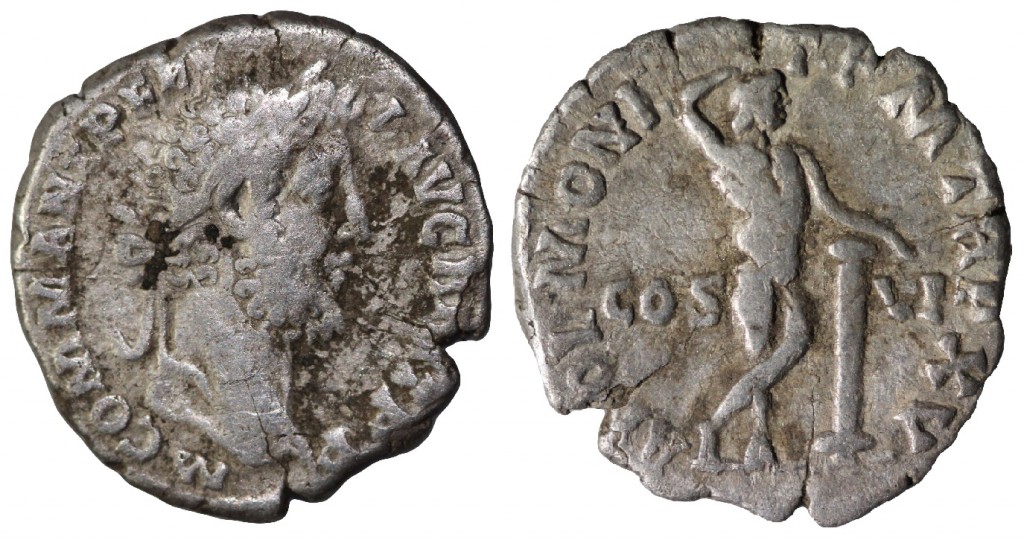July 7, 2015, by Will Leveritt
On this day in AD175 Commodus took the toga virilis, the sign he had entered adulthood
Text by Andrew Fox
Image © Mint Imperials
Commodus, an emperor enshrined in popular culture as the antagonist in Ridley Scott’s Gladiator, was born on the 31st of August, AD161. He was born to the reigning emperor, Marcus Aurelius, and his wife, Faustina the Younger. He was the first emperor to be ‘born in the purple’ (i.e. during the reign of his father), and was the first emperor to succeed his natural father since Titus succeeded Vespasian in AD 79.

AR denarius of Commodus. Obverse has laureate head of emperor right, M COMM ANT P FEL AVG BRIT P P. Reverse shows Apollo leaning on a column, APOL MONET PM TR P XV, COS VI. 18mm, 2.12g, 1 o’clock. This reverse type is only known under Commodus.
In AD 175, Commodus assumed the toga of manhood, the toga virilis, in preparation for the quelling of a rebellion against his father led by Avidius Cassius, a high profile senator and soldier, who some sources tell us had already been a cause of concern to Marcus’ co-emperor, Lucius Verus. He had both the reputation and the political influence to give due cause for concern to an emperor, since he had been rewarded with a suffect consulship and the high-profile governorship of Syria as a result of his role in the Parthian campaigns of Verus. Due to these roles, when Cassius made his bid for power, the (now sole) emperor, Marcus Aurelius, had to react.
Cassius’ rebellion, which formed the catalyst for Commodus’ coming of age, began with a rumour of the death of Marcus Aurelius, and this rumour prompted Cassius to make a bid for power, either as emperor himself, or as a regent until Commodus was fit to rule alone. Cassius had strong support from his countrymen in Syria, and several eastern legions rallied to him, as did the prefect of Egypt. Perhaps surprisingly, even once the rumours of Marcus’ death had been proved false, Cassius chose to continue his rebellion with all the aplomb of Magnus ‘I’ve started so I shall finish’ Magnusson. One source, the occasionally fantastical Historia Augusta, supposes that Cassius’ lust for power was genetic, condemning him as the descendent of the Cassius involved in Julius Caesar’s assassination.
In response to the rebellion, Marcus Aurelius, confident of his own vitality, sent his son Commodus to the front, where the young heir was presented with the toga virilis. Presented to Commodus at the age of fourteen (which was the normal age), the toga virilis replaced the tunic worn by boys, and symbolised a boy’s entry into adulthood. In Commodus’ case, it also signified that he was now a suitable representative of his father throughout the empire.
Commodus’ ascent to manhood, however, was not celebrated by the expected suppression of rebellion, and Avidius Cassius was mortally wounded by one of his own centurions before being finished off by a decurion. Once he had been decapitated, Cassius’ own men took the head to the emperor. The kindly Marcus is reported to have refused to even look at the head of the usurper, and was exceptionally lenient to all involved, only executing those who had openly committed crimes.
Unlike Cassius’ treachery, Marcus’ leniency was clearly not hereditary, and Commodus went on to become one of the cruellest emperors in the Roman Empire’s history. He ruled jointly with his father from AD 177 until Marcus’ death in AD 180, ruling alone until AD 192. Among Commodus’ first acts as sole emperor was the burning alive of every descendent of Avidius Cassius, and it was by this brutal act that Commodus’ maturation was, in a sense, completed. Commodus’ adulthood, begun under a cloud of war, ended in just as vicious a fashion. After reigning for twelve years, nine months, and fifteen days, (in addition to the three years, two months, and sixteen days alongside his father), Commodus was strangled in his bath by his wrestling partner, Narcissus, as part of a coup against him. Commodus’ death did not usher in an era of peace for the Empire, and the following year went down in history as the Year of the Five Emperors, during which the Empire was engulfed in conspiracy and assassinations at the highest level
No comments yet, fill out a comment to be the first

Leave a Reply